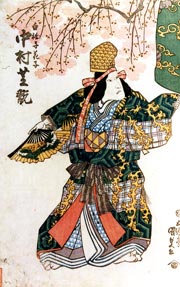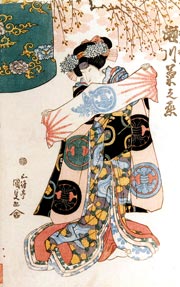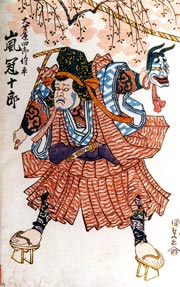| FUTA OMOTE DďJďJI |
| Play title | D˘j˘ji Koi ha Kusemono Futa Omote D˘j˘ji Kin no Zai Sarushima Dairi The Gold Shrine Offerings of Sarushima [1] |
| Authors | Tsuruya Nanboku IV Katsu Hy˘z˘ II Tsuruya Magotar˘ IV Nakamura Jűsuke IV Matsumoto K˘ji I |
| History |
Tsuruya Nanboku IV's drama "Kin no Zai Sarushima Dairi" was staged for the first time in the 11th lunar month of 1829 at the Nakamuraza [more details]. This was Tsuruya Nanboku IV's last drama as the playwright died at the end of the lunar month. The last act of "Kin no Zai Sarushima Dairi" was a spectacular d˘j˘jimono using Tokiwazu, Tomimoto and Nagauta musical ensembles. It was entitled "D˘j˘ji Koi ha Kusemono". In modern times, "Kin no Zai Sarushima Dairi" was revived by Ichikawa Ennosuke III in January 1964 at the Nissay Theatre [casting]. The final act was entitled "Futa Omote D˘j˘ji" and it used Nagauta and Tokiwazu ensembles. |
| Key words |
D˘j˘ji D˘j˘jimono Ennosuke Jűhachiban Ennosuke Shijűhassen Fujiwara Hidesato Fujiwara Tadabumi Fukkatsu T˘shi Ky˘gen Jűhachiban Futa-omotemono Jidaimono Kaneiri Keren Ky˘genshi Miidera Minamoto Mitsunaka Minamoto Yorimitsu Nagauta ďmi Oshimodoshi Shiraby˘shi Shosagoto Tada Mitsunaka Taira Masakado Takiyasha Tawara T˘ta Hidesato Tokiwazu Uroko Yoten |
| Summary |
Mitsunaka's son Yorimitsu arrives at the Miidera Temple [2] where the priests Hakuunb˘ and Kokuunb˘ [3] congratulate him on having been reinstated in his former position. They add that they have made secret preparations for a nuptial ceremony for Yorimitsu and Princess Nanaaya. Today is an important day: a bell reputed to have been brought from the Undersea Kingdom is to be installed in the temple. They have taken advantage of the situation to hide Nanaaya inside the bell (kaneiri). When the two priests pull the rope to raise the bell, Nanaaya emerges from inside, much to Yorimitsu's surprise. The lovers go off together, while the two priests retire to the side and start to take a nap. Suddenly a shiraby˘shi appears from inside the bell. The two priests wake up and question her. Learning that she is a shiraby˘shi, they ask her to perform a dance for them. She complies. But as the dance progresses, the acolytes become aware that the performer is not a woman but a man. The premises had been put off limits to men on this particular day in order to ensure Yorimitsu's complete privacy with Nanaaya, so the acolytes demand that the dancer identify himself. The dancer reveals that he is in reality a ky˘genshi named Masuroku. The two priest suspect he may be a spy, but Yorimitsu appears with Nanaaya and they join in the questioning. They demand that Masuroku prove he is a ky˘genshi by performing a dance for them. Masuroku starts to dance, using three different masks to portray three characters. When the performance is over the actor drops his masks. To Yorimitsu, Masuroku appears as the dead Princess Kiyo. To Nanaaya, he appears as the ghost of Tadabumi. Masuroku is in reality the spirit of both the jealous Princess Kiyo and the jealous Tadabumi. These two ghosts will take revenge against against the rival who has deprived them of their loved one. Masuroku vows to kill both Yorimitsu and Nanaaya. The two priests Hakuunb˘ and Kokuunb˘ come to their rescue and drop the bell, hiding the lovers inside. The frustrated Masuroku clambers to the top the fallen bell. It turns pitch dark, frightening the two priests who try to remember a charm by which they might bring the light back again. They chant an incantation. They now see Masuroku striking a menacing pose, and they run away in fright. Pursuers close in on Masuroku and a fight ensues. Masuroku uses his demonic power to raise the bell. Yorimitsu emerges with his magical Murasame sword. The ghost of Tadabumi in Masuroku tries to grab Princess Nanaaya, but Yorimitsu strikes him with Murasame. The bombastic warrior Tawara no T˘ta Hidesato comes swaggering to the site (oshimodoshi). He will fight against Masuroku. The demon now clambers up the bell and poses on top of it, glaring at his enemies below while fighters (uroko yoten) arrange themselves in such a way as to appear as the body of a huge serpent with Masuroku as its head. Summary edited by Marion Hudson |
| Notes |
[1] The title "The Gold Shrine Offerings of Sarushima" comes from Samuel Leiter's "Historical Dictionary of Japanese Traditional Theatre". [2] The final dance-drama is set at the Miidera Temple, not the D˘j˘ji Temple but this dance being a parody of "Musume D˘j˘ji", it has retained the name of the latter temple in its title! "Futa Omote D˘j˘ji" can be translated as "Double-Faced D˘joji". [3] The two priests, who are named Hakuunb˘ (the white cloud bonze) and Kokuunb˘ (the black cloud bonze), are a parody of the two priests in "Narukami". |
 |
 |
 |
|
The actors Nakamura Shikan II, Segawa Kikunoj˘ V and Arashi Kanjűr˘ I playing the roles of the shiraby˘shi Hanako, the shiraby˘shi Sakurako and ďashihara Shir˘ Masahira in the dance-drama "D˘j˘ji Koi ha Kusemono", which was staged in the 11th lunar month of 1829 at the Nakamuraza (print made by Utagawa Kunisada I) |
||
|
|
| Contact | Main | Top | Updates | Actors | Plays | Playwrights | Programs | Links | FAQ | Glossary | Chronology | Illustrations | Prints | Characters | Derivatives | Theaters | Coming soon | News |